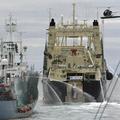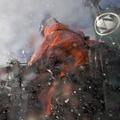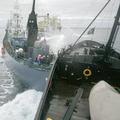 2月5日與日本船隻纏鬥5小時後,「海洋看守保育協會」(The Sea Shepherd)護鯨船史帝夫厄文(Steve Irwin)號在2月6日早晨,於南極羅斯海域與日本捕鯨船勇新丸2號(Yushin Maru No.2)相撞。在過程中,日本船員使用聲波武器、纏索和船隻攻擊史帝夫厄文號。
2月5日與日本船隻纏鬥5小時後,「海洋看守保育協會」(The Sea Shepherd)護鯨船史帝夫厄文(Steve Irwin)號在2月6日早晨,於南極羅斯海域與日本捕鯨船勇新丸2號(Yushin Maru No.2)相撞。在過程中,日本船員使用聲波武器、纏索和船隻攻擊史帝夫厄文號。
該國際海上哺乳動物保護組織「海洋看守保育協會」的創始人和領導人華生(Paul Watson)船長說,衝突起因於日本魚叉船介入阻撓史帝夫厄文號的行動。史帝夫厄文號企圖阻止一頭死鯨魚轉送到加工船日新丸號(Nisshin Maru)的船臺。
「如果不撞擊勇新丸1號,我無法轉向右舷。我盡力停下來,但是勇新丸2號的走向使碰撞不可避免。」勇新丸2號當時正轉送早上殺死的第2頭鯨魚。「對史帝夫厄文全體船員來說,這些毫無防備的鯨魚遇害,就像是失去他們自己生命一樣的悲劇,」華生說。
第2波衝突在2月6日下午發生,當時兩艘魚叉船衝向「海洋看守保育協會」對加工船的封鎖,該船正在轉送兩隻死鯨魚。
「我們告知他們停止其非法捕鯨行為,我們將阻斷加工船堅硬的船臺。他們決定測試我們的決心,且顯然期望我們在他們搶先轉送鯨魚後能撤退,」華生船長說。
日新丸號向史帝夫厄文號船員發射一種聲波武器,稱作長距離聲響裝置(LRAD)。此一新發展的武器會產生震耳欲聾的噪音,並造成聽力永久損害和暫時性的視覺混亂。
日本船員聲稱他們正進行合法科學研究,並自行決定在南極海域多達900頭的年度鯨魚配額。他們主張根據國際捕鯨委員會(IWC)規章,捕鯨研究是合法的。
「海洋看守保育協會」和其他保育組織認為日本人的捕鯨行動並不合法。「日本人捕鯨行為正違犯南極條約、瀕危野生動植物物種國際貿易公約,和國際捕鯨的委員會的規章協定,」華生說。
史帝夫厄文號直接於日新丸號船臺後方,試圖阻止一隻鬚鯨魚(minke whale)轉送到該加工船。
「看到那頭毫無防備的鯨魚,遭受長時間極度痛苦的殺害令我非常忿怒。我們今天將在這裡終止這令人憎惡的事件。此舉是危險的,但我們並不是來這邊坐待鯨魚遭到屠殺。我們來此阻止屠殺行為。我們居於很大的劣勢。日本政府將保護其屠殺者。我們的政府卻沒有那樣的膽識,更因我們保護自己和鯨魚而譴責我們。我們打算堅決抵抗。」華生船長說。
日本鯨類研究機構執行長森本實(Minoru Morimoto)6日在東京,指控「海洋看守保育協會」船員的犯罪攻擊行為。森本實說,「我將請求IWC的全體會員國譴責這些暴力行為,並拒絕該荷蘭籍船隻入港。」
2月5日,史帝夫厄文號讓日本捕鯨船隊疲於奔命,成功阻止其捕鯨行動,捕鯨船的不耐因而爆發。
5日午後,一頭瀕臨絕種的鰭鯨被認出。
史帝夫厄文號派出兩艘快速小艇下水阻止魚叉船捕鯨行動,並且以直升機拍攝整個行動過程。
「12點30分,日新丸號對來自加州的飛行員歐特曼(Chris Aultman )和來自塔斯馬尼亞島的動物星球(Animal Planet)頻道攝影師鄧恩(Ashley Dunn)發射LRAD。鄧恩當時正在替電視節目「鯨魚戰爭(Whale Wars)」拍攝「海洋看守保育協會」的護鯨運動。」華生說。
「捕鯨船員向直升機發射該設備是極不負責任的行為。他們除了拍攝之外,並未對捕鯨船造成任何威脅。這些捕鯨船員顯示他們對人命毫不關心。」華生說。
「當時,魚叉船又打開LRAD,朝向小船和史帝夫厄文號發射。這次聲波攻擊後,日新丸號隨後轉向追趕史帝夫厄文號,並且全速壓迫史帝夫厄文號。」華生說。
日本船員用高壓水管攻擊小船。小船也以威脅纏繞魚叉船推進器作為報復手段,並以腐壞奶油炸彈還擊。
在17小時後,魚叉船退出,史帝夫厄文號重新追蹤日新丸號,該船正前往南極,深入羅斯海域(Ross Sea)。
華生船長的策略是讓捕鯨船隊疲於奔命,以致無暇進行捕鯨行動。他說,「海洋看守保育協會」2008年成功阻止近500頭鯨魚遇害,並堅信這季會做得更好。
 「我希望我們不用面對如此危險的情勢。我已重複提及,假使澳洲或紐西蘭政府同意,在國際法庭上控訴日本政府,那麼我們將放棄這類行動。因為國際法並未執行,我們只能在這已規劃的鯨魚禁獵區中,用可獲得的資源來保護這些瀕臨絕種的鯨魚。」
「我希望我們不用面對如此危險的情勢。我已重複提及,假使澳洲或紐西蘭政府同意,在國際法庭上控訴日本政府,那麼我們將放棄這類行動。因為國際法並未執行,我們只能在這已規劃的鯨魚禁獵區中,用可獲得的資源來保護這些瀕臨絕種的鯨魚。」
澳洲直到1978年仍屬捕鯨國家,在1999年在其專屬經濟海域中,建立鯨魚禁獵區。
禁獵區在澳洲南極洲領土旁,包括其專屬經濟海域,6日的戰鬥正發生在那裡。
在2008年,澳洲聯邦法庭裁決,日本捕鯨船隊在鯨魚禁獵區殺死鯨魚是不合法的行為。
The Sea Shepherd whale conservation ship Steve Irwin collided with the Japanese whaling vessel Yushin Maru No.2 this morning in the Ross Sea after spending five hours Thursday in a battle with the Japanese, who used a sonic weapon, fouling lines and their ships to attack the conservation vessel.
Captain Paul Watson, founder and leader of the international marine mammal conservation organization Sea Shepherd, says the collision occurred as the Japanese harpoon vessel moved in to block the Steve Irwin's attempt to prevent the transfer of a dead whale up the slipway of the factory ship Nisshin Maru.
"I could not turn to starboard without hitting the Yushin Maru No.1. I tried to back down but the movement of the Yushin Maru No.2 made the colliA second collision happened this afternoon when two of the harpoon vessels ran the Sea Shepherd blockade of the slipway to transfer two dead whales to the factory ship.
"We told them to not continue their illegal whaling operations and that we would be blocking the stern slipway of the factory ship," said Captain Watson. "They decided to test our resolve and apparently expected us to retreat when they charged in ahead of us to make the transfer."
The Nisshin Maru blasted the crew on the Steve Irwin a sonic weapon called a Long Range Acoustical Device, or LRAD. A newly developed weapon that blasts earsplitting noise, the LRAD can produce permanent hearing damage and temporarily disrupt vision.
sion unavoidable," Watson said.
The Yushin Maru No.2 was transferring a second whale killed this morning. "To the Sea Shepherd crew the murder of these defenseless whales is as tragic as if they had lost one of their own," Watson said.
The Japanese say they are conducting legal whaling for scientific purposes with a self-assigned annual quota of more than 900 whales in the Southern Ocean. They maintain that research whaling is legal under the rules of the International Whaling Commission, IWC.
The Sea Shepherd and other conservation groups call the Japanese whaling illegal. "Japanese whaling is violating the Antarctic Treaty, the Convention on Trade in Endangered Species of Flora and Fauna and the regulations of the International Whaling Commission," said Watson.
The Steve Irwin is now directly behind the slipway of the Nisshin Maru attempting to block the transfer of the minke whale's body to the factory ship.
"Seeing the long prolonged agonizing murder of that defenseless whale has made me angry," said Captain Watson. We are going to make a stand here today to shut this obscenity down. It will be dangerous but we did not come down here to witness the slaughter of whales, we came down to stop the killing."
"We have a very big disadvantage," said Watson. "Japan will defend the violence of their mad dog killers. Our governments don't have the guts and will condemn us for defending ourselves and the whales. Sometimes you just have to say, what the hell and make a stand and that is what we intend to do here today. We intend to make a stand."
Minoru Morimoto, director-general of the Japanese Institute of Cetacean Research today in Tokyo,accusing the Sea Shepherd crew of "criminal attack," Morimoto said, "I call on all member nations of the IWC to condemn these acts of violence by Sea Shepherd and for countries to close their ports to the Dutch vessel."
On Thursday, the fifth day that the Steve Irwin had prevented any whaling by the Japanese fleet by keeping them on the run, the frustration of the whalers erupted.
An endangered fin whale was spotted just after noon.
The Steve Irwin launched two fast inflatable boats to head off any attempt to harpoon the whale and launched its helicopter to film the blocking action.
"At 1230," said Watson, "the Nisshin Maru aimed the Long Range Acoustical Device at helicopter pilot Chris Aultman of California and Animal Planet cameraman Ashley Dunn of Tasmania," who is filming the Sea Shepherd campaign for the TV show "Whale Wars."
"It was extremely irresponsible for the whalers to aim that device at the helicopter," said Watson. "They were doing nothing but filming and presented absolutely no threat to the ships. They demonstrated absolutely no regard for human life."
At this point, the harpoon vessels turned on their LRAD and aimed it at the small boats and the Steve Irwin. "This sonic attack was followed by the Nisshin Maru turning into the Steve Irwin and attempting to actually ram the Sea Shepherd vessel at full speed," Watson said.
The Japanese crew shot the small boat crews with high-pressure water hoses.
The small boats retaliated by threatening to foul the props of the harpoon vessel and also with rotten butter bombs.
At 1700 hours, the harpoon boats backed off and the Steve Irwin resumed the pursuit of the Nisshin Maru, heading due South deep into the Ross Sea.
Watson's strategy is to keep the whaling fleet on the run so they cannot kill whales. He says the Sea Shepherd was successful last year in preventing the killing of close to 500 whales and is confident of doing even better this season.
"I wish we did not have to be down here in this dangerous situation," said Captain Watson. "I've said repeatedly that if Australia or New Zealand would agree to take Japan to the international court on this then we would back off."
"Because international law is not being enforced, we have no choice but to do what we can with the resources available to us to defend these endangered whales in this established international whale sanctuary."
A whaling nation until 1978, Australia established a whale sanctuary in its Exclusive Economic Zone in 1999.
The sanctuary includes the EEZ around the Australian Antarctic Territory, where today's battle is taking place.
In 2008, the Australian Federal Court ruled it was illegal for the Japanese whaling fleet to kill whales in the sanctuary.



